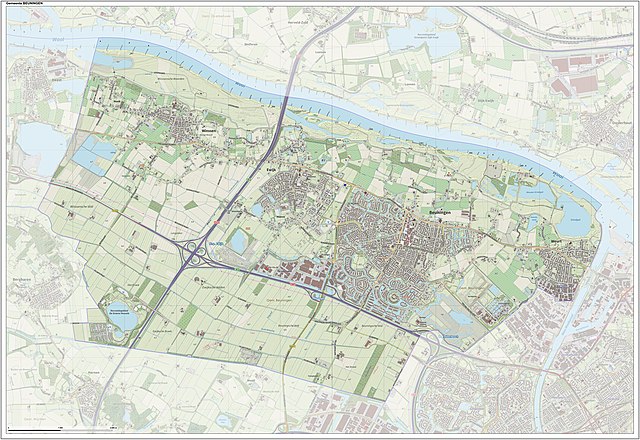Top Qs
Timeline
Chat
Perspective
Beuningen
Municipality in Gelderland, Netherlands From Wikipedia, the free encyclopedia
Remove ads
Beuningen (Dutch pronunciation: [ˈbøːnɪŋə(n)] ⓘ) is a municipality and a town in the eastern Netherlands. The municipality consists of the towns Beuningen, Ewijk, Winssen and Weurt. 1.5 kilometres (1 mi) to the north lies the river Waal
Beuningen lies adjacent to the A73 (Nijmegen-Venlo, on the south side) and A50 (Zwolle-Eindhoven, in the west) motorway interchange. East of Beuningen lies the city Nijmegen. Beuningen had a population of 26,157 in 2021. There is a restored windmill in the town, De Haag.
Remove ads
Population centres
History
The area in and around Beuningen was inhabited by the Romans. There are regularly excavations done in which Roman rests are found. In the 15th century there stood a small castle: Blanckenburgh. It was probably destroyed during the Eighty Years' War by Maurice of Orange. Until about 1900 Beuningen was a poor farmers village, often struck by floods. Nevertheless, there were a few rich families, mostly farmers with a lot of land, who paid the highest tax in the area. On 1 January 1818 the municipality annexed the town of Weurt to the east, and on 1 July 1980 the town of Ewijk to the west.
Nowadays Beuningen has grown to a suburb of Nijmegen, with a lot of new neighbourhoods.
Remove ads
Topography
Dutch Topographic map of the municipality of Beuningen, June 2015.
Monuments
There are several monuments in Beuningen. Here are a few (in chronological order):
- Blanckenburgh tower, 15th century
- De Haag Mill, 1704
- Kloosterstraat farm, 1774
- Olden Tempel, 1838
- Large Waardhuizenstraat T-farm, 1850 – 1900
- Mausoleum of Van 't Lindenhout, 1861
- Cornelius church, 1900–1901
- Vinkendael, 1900
- Coach house, ca. 1913
- Holy Heart statue, 1920
- Stone factory the Bunswaard, 1920
See also
Notable people
- Willem Joseph baron van Ghent tot Drakenburgh (1626 in Winssen – 1672) a 17th-century Dutch admiral
- Willie Smits (born 1957, in Weurt) a trained forester, microbiologist, conservationist, animal rights activist, wilderness engineer and social entrepreneur in Borneo
- Bas van Bemmelen (born 1989 in Beuningen) a volleyball player with the Netherlands men's national volleyball team
Gallery
- Beuningen, church: de Corneliuskerk
- Beuningse Uiterwaarden during high water in the Waal
- Sculptuur made by Ronald Tolman in Beuningen
- Artwork 'De Cirkel' by Anneke van Bergen on roundabout in Beuningen
- Ewijk, tower: the Oude Toren
- Ewijk, Beuningen, scheepvaart op de Waal
- Weurt, Beuningen
- Winssen, medieval church tower
References
External links
Wikiwand - on
Seamless Wikipedia browsing. On steroids.
Remove ads












